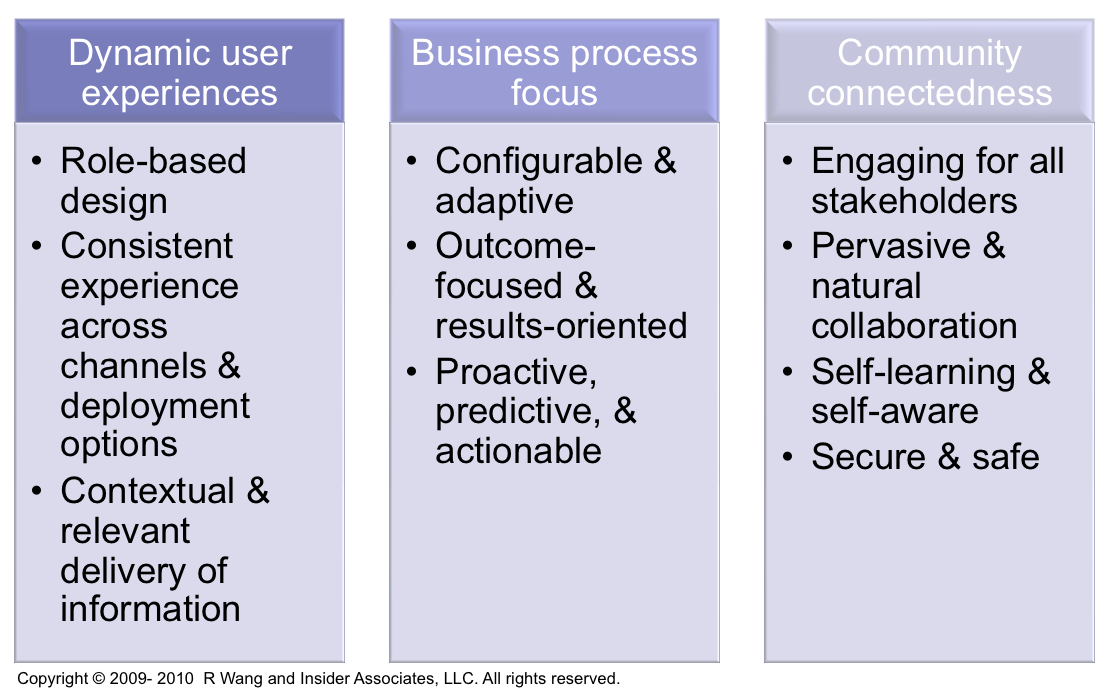Monday's Musings: 10 Essential Elements For Social Enterprise Apps

Convergent trends fuel the push for new business solutions and platforms
The future of enterprise software is evolving from web-based apps, business process platforms, and service-enabled products; to a new class of more connected, social, and collaborative business software solutions. This transformation comes from advances in the Web 2.0 world and a growing realization that business solutions must reflect how people actually perform work. These trends point to a convergence and expansion of 10 mega themes:
- Evolution versus revolution
- Top down versus bottom up
- Reactive versus proactive
- Transactional versus behavioral
- Strategic versus tactical
- Horizontal versus vertical
- Individual versus community
- Company versus customer
- B2B versus B2C
- Data generation versus data analysis
Future business solutions and platforms will expand beyond Enterprise 2.0 and the knowledge worker
After much digestion of what's happening in the various Enterprise 2.0 models, (e.g. Dion Hinchcliffe's FLATNESSES mnemonic) and studying the Social CRM market, (e.g. CRM Magazine's June 2009 "Social Media Maturity Model"), what's next for business solutions or enterprise apps appears to be something bigger than usability, collaboration, social media, mobility, and technologies for the knowledge worker. Enterprise 2.0. as defined by Andrew McAfee in his April 2006 MIT Sloan Management Review, touches on a world of emergent, free-form, collaboration that bring such Web 2.0 tools to the enterprise. This definition provides a solid basis for building on key concepts in this emerging class of software solutions and platforms. In fact, this new category moves beyond today's Enterprise 2.0 definition and most certainly beyond the three letter acronym world of ERP, CRM, HCM, PBS, SCM, etc.
Ten elements define this next generation of enterprise business software solutions
Recent conversations with software vendors, industry luminaries, and customers highlight 10 elements required for future solutions (see Figure 1.). These elements include dynamic user experiences, business process focus, and community connectedness across 10 elements:
- Role-based design. Software designed around how users perform work including applicable security models.
- Consistent experience across channels & deployment options. Software that is agnostic to where or how that software is deployed and accessed.
- Contextual & relevant delivery of information. Software which understands what information to provide users at a point in time
- Configurable & adaptive. Software that can be modified to meet changing conditions.
- Outcome-focused & results-oriented. Software that tracks key metrics across an end to end process.
- Proactive, predictive, & actionable. Software that anticipates requests and supports decision making.
- Engaging for all stakeholders. Software that opens up the system to new types of users, collaborators, networks, and communities.
- Pervasive & natural collaboration. Software that embeds knowledge worker skills into existing work flows.
- Self-learning & self-aware. Software that tracks preferences and identifies patterns for future correlation.
- Secure & safe. Software that meets security and disaster recovery thresholds.
Figure 1. 10 Elements Of Social Enterprise Business Solutions and Platforms

The Bottom Line - customers ready to transition must align with the right hierarchy of needs and design an apps strategy
Many surveys and studies about software budgets show that organizations devote 2/3's to keeping the lights on and 1/3 to new projects and innovation. In order to pave way for these new connected, social, and collaborative business software solutions, clients will have to fund these investments via apps strategies that deliver efficiency and massive reduction of costs. These strategies will require a focus on business process optimization, technology strategies, and ecosystem leverage. Form must follow function.
Your POV.
What elements are missing from the 10 for Social Enterprise Apps? Do we have the right name for these solutions? If not, what category of software should we be calling this? Need assistance in crafting your future apps road map and strategy? Please post your comments here or send me a private email to rwang0 at gmail dot com or r at softwareinsider dot org.
Copyright © 2009 R Wang. All rights reserved.
 R "Ray" Wang
R "Ray" Wang R "Ray" Wang
R "Ray" Wang